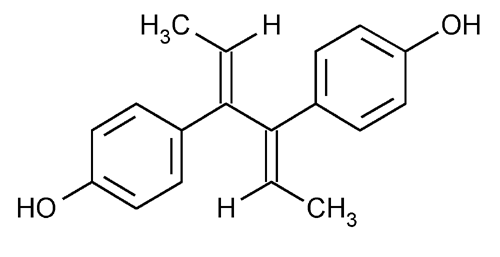Dienestrol
Phenol, 4,4¢-(1,2-diethylidene-1,2-ethanediyl)bis-, (E,E)-.
(E,E)-4,4¢-(Diethylideneethylene)diphenol
» Dienestrol contains not less than 98.0 percent and not more than 100.5 percent of C18H18O2, calculated on the dried basis.
Packaging and storage—
Preserve in well-closed containers.
Identification—
B:
Ultraviolet Absorption  197U
197U —
—
Solution:
5 µg per mL.
Medium:
alcohol.
Absorptivities at 228 nm, calculated on the dried basis, do not differ by more than 3.0%.
C:
To a solution of about 10 mg in 0.5 mL of alcohol add 1 mL of hydrochloric acid and about 50 mg of vanillin: a blue color is produced immediately, and it persists on dilution with water but disappears on the addition of alkali (distinction from diethylstilbestrol, which produces no color).
Melting range  741
741 :
between 227
:
between 227 and 234
and 234 , but the range between beginning and end of melting does not exceed 3
, but the range between beginning and end of melting does not exceed 3 .
.
Loss on drying  731
731 —
Dry it at 105
—
Dry it at 105 for 2 hours: it loses not more than 0.5% of its weight.
for 2 hours: it loses not more than 0.5% of its weight.
Residue on ignition  281
281 :
not more than 0.2%.
:
not more than 0.2%.
Assay—
Mobile phase, Internal standard solution, and Standard preparation—
Prepare as directed in the Assay under Dienestrol Cream.
Assay preparation—
Transfer about 25 mg of Dienestrol, accurately weighed, to a 100-mL volumetric flask. Add methanol to volume, and mix. Pipet 2 mL of this solution, 5 mL of Internal standard solution, and 5 mL of water into a 50-mL volumetric flask. Dilute with methanol to volume, and mix.
Procedure—
Proceed as directed for Procedure in the Assay under Dienestrol Cream. Calculate the quantity, in mg, of C18H18O2 in the portion of Dienestrol taken by the formula:
2.5C(RU / RS).
Auxiliary Information—
Please check for your question in the FAQs before contacting USP.
| Topic/Question | Contact | Expert Committee |
| Monograph | Daniel K. Bempong, Ph.D.
Senior Scientist 1-301-816-8143 |
(MDPS05) Monograph Development-Pulmonary and Steroids |
| Reference Standards | Lili Wang, Technical Services Scientist 1-301-816-8129 RSTech@usp.org |
USP32–NF27 Page 2134
